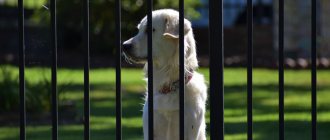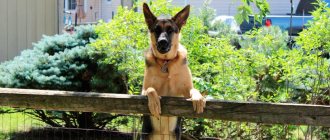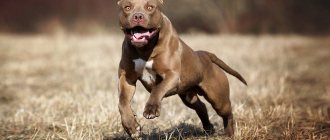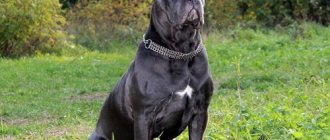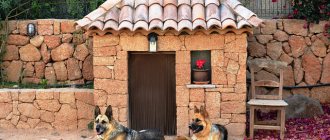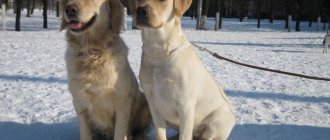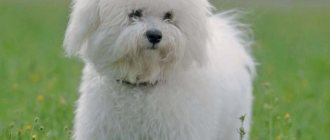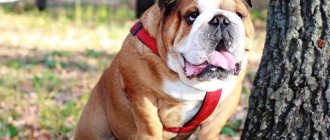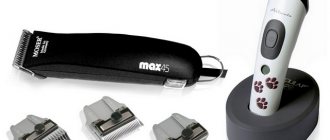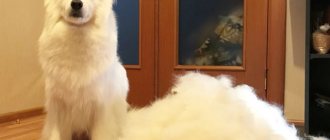Professional breeders and people living in private homes keep animals both indoors and outdoors, having set up special enclosures. When choosing this method of keeping, it is important to ensure that the dog has enough space, the enclosure is warm and protected from drafts. The size of the room should not be less than 7 square meters, have a good roof and wooden flooring and good lighting.
By taking care of the arrangement of the enclosure in advance, the owner will be able to organize a good house for his pet without worrying about his health.
What dog breeds are suitable for kennel keeping?
The positive side of street keeping is that the dog is always in the fresh air and does not suffer from a lack of territory. Despite the pronounced advantages of street living, not all dogs are able to live in such conditions. It is not recommended for short-haired and decorative dog breeds to live in an enclosure, as they can freeze and often catch colds.
Not all people can afford to build an enclosure on their property. It is necessary to have enough space, especially if the dog is large. The larger the animal, the more territory it needs to be allocated for the construction of an enclosure.
Most often, kennel keeping of dogs is preferred by owners who want to protect their territory from uninvited guests. Dogs of guard breeds feel good in enclosures, serving and protecting the owners’ home from intruders.
Large breed dogs—service or guard dogs—feel best in an enclosure. Shepherd dogs can also be kept in the enclosure. The following dog breeds are excellent for kennel keeping:
- alabai;
- black Russian terrier;
- Moscow watchdog;
- East European and Caucasian Shepherd Dogs.
The animal will perform its assigned security functions much better if the conditions of its keeping are as comfortable as possible. It is important to take care of a warm booth that protects your pet during bad weather.
The enclosure should be spacious enough so that the animal can easily move around it, stretching its paws.
When planning the construction and arrangement of an enclosure, it is important to take into account the growth of the animal. So, for such dog breeds as the American Bulldog, Giant Schnauzer, Rottweiler, the enclosure may be slightly smaller than for the Moscow Watchdog or Alabai.
It is necessary to take into account the breed characteristics of animals. Thus, short-haired dogs do not tolerate cold well, so it is important for them to equip an enclosure with an additionally insulated booth.
Types of enclosures
According to the material from which the enclosure is made, it can be:
- Wooden.
- Metallic.
- Combined
According to the degree of openness and insulation, enclosures are divided into:
- Open.
- Partially open.
- Partially insulated.
- Fully insulated over the entire surface.
These indicators depend on the time of year.
Dimensions
In terms of size, only a large enclosure is suitable for a Rottweiler, out of the existing small and medium ones.
NOTE!
Since the Rottweiler is a fairly large and bulky breed of dog, the size of its enclosure should be at least ten square meters.
The height of the enclosure should also be large . This way the dog will receive as much light as possible in warm weather.
A booth located inside the enclosure will help protect you from the cold.
How to set up an enclosure for a dog
When planning to keep an animal outside the house, the owner needs to ensure that it is cool in the summer and not freezing in the winter. The enclosure must be secure enough so that the dog cannot escape and run around.
The main requirements for arranging a reliable enclosure are:
- large space;
- good lighting;
- protection from cold and drafts;
- availability of fresh water and food;
- presence of toys.
It is imperative to remember that an enclosure measuring 2*3 meters is only suitable for spending several hours a day, but not on an ongoing basis.
A dog outside should not sleep on the bare floor. It is important that the pet has its own booth. It is necessary to determine where the booth will be located. This should be a comfortable place, moderately sunny and protected from drafts. It is better to leave the production of the booth itself to professionals. You can order a booth made of wood or durable environmentally friendly plastic.
In the booth, the pet must move freely and stand up to its full height. At the same time, there should not be too much space so that the booth is comfortable. It’s great if the entrance to the booth is not located immediately in the center, but slightly offset. This will allow the animal to have its own cozy place where it can curl up and stay warm in cold weather, protected from strong winds.
Professional breeders who keep animals in enclosures recommend equipping the kennel with a warm, but removable roof.
Thus, the cleaning process will be greatly simplified. In winter, it is recommended to cover the entrance to the booth with a blanket to prevent drafts from penetrating inside.
Bedding for kennel dogs must be of high quality. It is not recommended to choose bedding made from hay or straw, as this poses a potential risk for the development of ectoparasites. Fleas and ticks thrive in such conditions. In addition, straw and other types of organic bedding may contain enterobacteria - E. coli, salmonella or nematodes. This is due to the fact that straw and hay are not treated with disinfectants.
When choosing organic bedding, it is better to pay attention to cedar or pine sawdust, which absorb moisture and various odors well. In addition, sawdust is soft, environmentally friendly, and easy to dispose of. The specific smell of cedar and pine sawdust repels insects, ticks and fleas.
Sawdust is an excellent bedding for dogs kept in an enclosure, but it has a number of contraindications. It is not recommended to use this type of bedding for females during the period of bearing puppies, as well as for a dog that has just given birth to babies. Sawdust may contain Klebsiella, which penetrates the wood when processing logs.
Any warm material is suitable as bedding. These could be warm blankets, old sweaters or other things. It is necessary to ensure that the fabric does not fall apart into threads and does not contain sharp parts or buttons. All this can cause harm to the animal.
Keeping the dog in an enclosure does not require keeping the dog on a chain. Not only is this inhumane, it can cause harm to the animal. If an animal becomes entangled in it, it can cause serious harm to itself. The psychological and physical state of the animal is disturbed. In the future, instead of an obedient dog, the owner will be able to get an uncontrollable, eccentric animal.
When planning to keep a pet in an enclosure, you need to take care not only of the cleanliness and strength of the structure itself. Proper preparation is important.
The dog is gradually accustomed to the enclosure. First, the dog is left for several hours. Over time, the animal will get used to it and feel good in a comfortable enclosure.
Do you want to know more about the article or something? Call +79774692712, we will advise you.
14 minutes to read
Dogs are brought into private homes for various reasons. Some find it easier to live under the protection of faithful four-legged bodyguards, others get watchdogs to protect their property, and others simply need a companion. To answer the question “which dog is best to bring into a private home,” you need to know for what purpose you plan to use the pet.
Price range
The price of an enclosure usually depends on the material from which it is made, as well as the complexity of the design.
The most expensive combined enclosures . But if you are going to buy or build it from expensive wood or metal, then the price will be appropriate.
For example, when purchasing an oak enclosure with metal rods, you will pay 95 thousand rubles for it. Length, width and height are respectively 4x3x2.5 meters.
For an enclosure, consisting mainly of a lattice, with a metal roof, you will have to pay 52 thousand rubles. Its dimensions will be 3x2x2 m. This is the lowest price for an outdoor enclosure.
CAREFULLY!
Enclosures less than 50 thousand rubles are most often made of low-quality materials; they are short-lived and quickly become unusable.
Also, their components can be toxic to dogs.
Purchasing a cheap design risks the fact that even the dog itself can break, for example, the exit grate and escape outside . The roof of such enclosures leaks, they are not insulated, and in winter the dog will feel uncomfortable in this structure.
In the worst case scenario, the enclosure could collapse directly on top of the animal.
The average price for a “house” for an animal is 60 thousand rubles . This is the best money to purchase, if not the highest quality materials, then at least those that can last your pet 6-7 years.
Additionally, you can only spend money on insulating the floors and walls.
If you buy an enclosure for more than 95 thousand, you risk being deceived . Good and high-quality materials can be bought for less.
Which dog is better to bring into a private home - breeds and their characteristics
We analyzed the characteristics of different dog breeds that are suitable for keeping in private homes. In our material you will find a selection of the best breeds and their brief descriptions. We hope this will help you understand which breed is best for you and make your choice.
Depending on the function that the owners assign to their pet, dog breeds can be divided into several types.
- Watchdogs are the best breeds for protecting a private home, yard area, farm, property. The main calling of these pets is to protect the owner’s property from unauthorized access around the clock. The guards scare away, detain and drive away intruders.
- Bodyguard dogs are dog breeds not for protecting the home, but for protecting children and other household members. Accompanying and ensuring safety while walking is one of the functions of these protectors.
- Family companions – dog breeds for a private home, family friends. The function of companions is to brighten up loneliness and provide company.
- Shepherd dogs are breeds for farms. Farmers' four-legged assistants help with the work of grazing livestock and guard the plot.
- Hunting dogs are breeds for those who hunt. These animals help hunters, accompany mushroom pickers, and keep company while fishing.
Important: when deciding which dog is best to bring into a private home, have a clear idea of what you expect from your future pet.
Winter nutrition recommendations
During the cold season, the dog requires more high-calorie food. After all, the animal has to expend more energy because it needs to warm up, which means the body needs additional nutrition. For pets eating light food and who will spend the winter outside, it is better to switch to food for dogs leading an active lifestyle. And for “home guards” who eat natural food, the food should be sufficiently high in calories and fat. Oil should be added to the porridge, and the amount of meat products should be increased.
Even if there is snow around in winter, this does not mean that the dog does not need to drink. To prevent the water in the bowl from freezing, you need to add a little vegetable oil.
Don't forget to like
, write your comments and subscribe to our channel. This will be very good support for us to release new materials!
Also read our
website ! There are interesting and informative articles there!
Winter is a difficult test for any animal. Dogs are no exception. Even if they are hardy and cold-adapted breeds, you need to know how to prepare your dog for winter and how to care for it properly.
Unfortunately, many owners of four-legged pets do not know that caring for animals in winter requires much more attention than at other times of the year. And that's why.
Content:
- What determines whether a dog is cold in winter?
- Dog breeds for winter
- Do dogs' paws get cold in winter?
- The main thing about caring for your dog in winter
The best dog breeds for guarding a private home
Which guard dog should you choose to guard a private home? Our selection of breeds will help you answer this question. The breeds are listed in alphabetical order.
Akita Inu
“The Quiet Watchman” is what these incorruptible dogs are called. Akita Inus do not raise their voice without a reason. Hereditary watchmen do not have a frightening size and appearance, but they have the proper amount of aggression in their character and have remarkable strength.
Alabai
Perhaps this is the best guard dog breed for guarding a private home. There is not a person who would want to enter the area with Alabai in a sober mind. This large guard dog is extremely unfriendly to everyone who appears in the protected area, he defends it to the last.
Dogue de Bordeaux
You can immediately feel sorry for everyone who tries to break into yours - not a single burglar will escape the strong grip of this dog. Dogs are used to guard household property; they are not suitable as guards on the property.
Construction
A dog house is built mainly in 3 ways. A capital booth is built like a house, from the base to the roof, with the walls erected from bottom to top and finishing. The 2nd method is similar to frame-panel technology: wall panels are hung on a durable frame made of timber. The 3rd can be called summer-dacha - a light but durable booth is made of plywood, waterproof or impregnated with water repellents (water-repellent compounds, for example, the same water-polymer emulsion), and for the winter the whole thing is brought onto a covered veranda or into the house. There are also original ways to build warm winter booths and kennels, see for example the video: https://www.youtube.com/watch?v=hUPLwyhpd7s.
About materials
The best material for building a doghouse is seasoned coniferous timber without falling knots and wane (i.e. edged). Cross-layering and curliness are not particularly important, because the loads in the structure are small, but the boards and beams need to be taken tongue-and-groove, planed and without cracks: a splinter in a paw pad or a torn claw can cost an expensive visit to the veterinarian. Fresh lumber that oozes and smells of resin is also not suitable. High-quality used timber from dismantled buildings is very suitable; it does not interfere with the dog’s sense of smell.
Note: the curtain-apron covering the opening in the booth should also be made of natural material. Preferable is a regular tarpaulin, and by no means rubber.
Thoroughly
The first method is illustrated in Fig. First, the bottom is knocked down from boards 40 mm thick, and on it is a supporting frame made of timber (40-50) x 100, pos. 1. Then they install corner posts made of 100x100 timber on self-tapping screws and sheathe the walls from the outside, pos. 2. Of course, sheathing boards must be installed with the tongue tongue up and the groove down. Upon completion of the cladding, openings are cut out and the outside of the building is treated with an antiseptic, then with a water repellent (in exactly this sequence), platbands are stuffed in the corners (required!) from the same boards, and they are treated in the same way, pos. 3.
Construction of a permanent dog house
The next stage is waterproofing the bottom and installing supports. A sheet of waterproof or impregnated plywood is placed on the bottom, wrapped in glassine or its equivalent with a fold inward of at least 15-20 cm. The corners of the waterproofing are not cut through, they are folded. After applying the insulating shield, lay beams from timber or install trenches and knock everything together with nails, pos. 4. You cannot use self-tapping screws; they will pull and tear the insulation! Also, do not drive nails directly into the insulating film. Slegs or trenches, of course, must be hydrophobized in advance.
Now it’s the turn of internal insulation and insulation. From the inside, the floor and walls are covered with glassine on small nails with linings for caps made of 2-4 mm plywood or thin container boards approximately 30x30 or 40x40 mm. Often they don’t nail it down so that the film doesn’t slide off. It is best to lay the sheet on top, fold it inward until you get even folds at the corners and nail it at the top along the contour. After this, slats are filled into the bottom frame and on the walls to the thickness of the thermal insulation (from 20x20 to 40x40) in increments equal to the width of its mat (slab). Next, thermal insulation is laid; if mineral wool is used, then you need to take long-fiber one. Also at this stage (item 5) a subfloor is laid from a board of twenty or 8-12 mm container.
Note: at this or the next stage, you must not forget to drive the corner posts into the ends and process the nail holders of the roof, if it will be a house.
Next, the entire box is again insulated from the inside and sheathed with plywood. You can use ordinary, self-impregnated one, but in this case only a water-polymer emulsion is suitable for impregnation, and then before installing the ceiling the structure will need to be thoroughly dried for 3-4 days: a dog’s nose can smell the smell of PVA, which is imperceptible to us. When the booth is lined from the inside, small, from ten to twenty, wooden fillets, pos. 6; You can use MDF.
Note: if foam plastic was used to insulate the walls, then at this stage the visible gaps need to be foamed, see fig. on the right, otherwise there is a risk that parasites will appear.
The penultimate stage is the construction of a removable ceiling, as described above, pos. 7. As for the roof, pos. 8, then now it can be anything depending on the location of the booth, your taste, skill and availability of materials. For example, how to build a warm booth with a flat roof in a similar way, see the video:
Video: how to make an insulated dog house
Frame
The diagram for constructing a frame booth is shown in Fig. First, a frame is assembled from (60-100) mm timber, the floor is built as in the previous case, and the walls and ceiling are sheathed with insulated panels. The structure of the panels can be different, from the same as that of a ceiling pie for a capital booth, to glass-magnesite slabs cut to size. But, generally speaking, a frame booth is an option for the lazy and not very smart. In all respects it is inferior to the capital one, but for temporary/seasonal use it is too expensive and labor-intensive.
Construction of a frame dog house
Plywood
The dimensions of the parts of a plywood box for a medium-sized guard dog or mongrel are shown in Fig. on right. The assembly technology is simple:
Details of a plywood dog house
- A frame of 40x40 bars is stuffed onto the bottom sheet and insulation is placed in it, inset in Fig.
- The side walls are nailed to the bottom frame.
- The same 40x40 timber is stuffed into the corners inside.
- Alternately laying the building on its side, lay insulation in the wall frames and sew them up with sheets of plywood; in the facade you will have to frame the entrance opening with pieces of the same timber.
- Roof holding nails are driven into the ends of the corner posts. In this case, because the racks are thin, you need to take them 5-6 mm in diameter and drill a guide socket 3-4 mm in diameter and 20-30 mm deep under each; if you hit it directly at the end, the block may crack.
- They make a roof, put it on holders - it’s done.
The question may arise: why do you need thermal insulation in a summer hut? From overheating by the Sun. For the same purpose, it is advisable to paint the outside of the booth in light colors and place it in the shade. The stands are bricks.
How to raise a guard dog
If you decide to get a dog instead of an alarm system, you must learn how to raise it correctly. Without proper upbringing and training, a puppy will not turn out to be a reliable guard at home.
Parenting Tips:
- Watchmen are trained from a very early age. First of all, the dog is taught respect for each member of the family. She must learn to distinguish her own from strangers.
- Secondly, they teach the puppy to take food only from the owner’s hands. One person must feed! If you strictly adhere to this rule, no one else will be able to feed the watchman.
- Guests of the house are prohibited from petting the dog and attempts to give treats are stopped. Thus, her social circle is strictly limited. The watchman must understand that his main task is to protect his people and home.
- A mandatory requirement is early socialization. To do this, it is imperative to walk the animal outside the yard.
- There is no need to try to dominate your pets 100%. A watchdog must learn to quickly react to unusual and dangerous situations without a command.
Which guard dog to choose to guard a private home, choosing from these or other breeds, you decide for yourself. Next, let's talk about which dogs best serve as a personal bodyguard.
How to make a booth with your own hands?
The classic version of the booth is a wooden booth.
It perfectly protects from both cold and heat, breathes and does not emit harmful substances. Such a structure will serve the dog for 6-7 years.
Here are instructions on how to build a doghouse with a pitched roof.:
- From 100 by 100 bars, put together the base of the floor. Place the frame on a flat surface and fill one side with a sheet of plywood to size. Turn the structure over and lay foam, polystyrene foam or mineral wool between the beams. Stuff the plywood on the other side. The floor is ready.
- Install two vertical bars on the base along the height of the facade and two bars on the other side, but a little shorter - this will be the slope of the future roof. Use a leveler to check that the bars are vertical. It is better to fasten the bars with wood screws and metal corners.
- Separately from the structure, connect three bars into a U-shaped structure according to the size of the hole, again using self-tapping screws and metal corners. Screw it to the base where needed.
- Cover the outside of the structure with plywood or OSB. Lay a layer of insulation on the inside in the same way as on the floor, then make the inner lining.
- The roof is made in the same way as the floor, but a little larger in size so that it protrudes slightly beyond the structure. The roof is attached to the kennel, covered with roofing felt or covered with slate.
- Install the booth on thick beams or bricks.
With these recommendations you can build a brick booth:
- Level and clear the area before construction. Mark the contours, then dig a 25x25 cm trench around the perimeter for the foundation. After this, fill it with concrete and leave it to dry for several days.
- Once the concrete has hardened, begin laying out the walls. When building, do not forget to check the verticality of the structure and compliance with right angles. At the location of the hole, pass the required number of bricks along its width. After the masonry reaches the height of the hole, place a wooden beam on top and continue laying it completely.
- After you finish construction, be sure to insulate the booth from the inside with wooden sheathing. Also cover the floor with wood.
- On the roof, it would be best to make a ceiling from boards or plywood. Only then can the roof be installed directly. For example, it could be made of slate.
The best breeds of bodyguards for protecting a private home
Bodyguard dogs must be able to do two things. The first is to understand when a person is in danger and truly needs protection. The second is to be able to stop in time.
These breeds of dogs are not taken to guard the house, but to protect the owner’s children and other family members:
- American Staffordshire Terrier . The short-haired dog with a squat body resembles in appearance another breed - the American Pit Bull Terrier. This similarity is terrifying. Dogs intuitively sense dangerous encounters and are ready to fiercely and unsparingly defend a person.
- Boxer. A self-confident dog does not trust strangers; all strangers are under suspicion. Infinitely devoted to his owners, he shows miracles of fearlessness in dangerous situations.
- Dutch Shepherd. An animal with highly developed territorial instincts copes well with the role of a guard.
- Giant Schnauzer. A fairly large, menacing-looking dog is considered an ideal bodyguard. In dangerous situations, dogs act without unnecessary hesitation and quickly neutralize intruders even in a crowd of people.
- Rhodesian Ridgeback. These are real bodyguards who are ready to resolutely protect their owner from any danger.
How to train a puppy
If you need to house train a small puppy, almost all of the above recommendations are suitable for this purpose. The puppy's kennel should already be sized for its adult state - it is strictly not recommended to change the old housing for a new one when the pet grows up. Also take care that there are no cracks or leaks in the box: it is important that the small guard pet is comfortable in its house.
When training a puppy to be in a kennel, the recommendation to carry out this process gradually comes to the fore. You should not cause negative emotions in an animal by locking it alone for a long time, forcibly putting it on a chain, or scolding it. All these moments can permanently discourage a pet from approaching “home” at all.
You should not stay near the puppy all the time while he gets used to the new place. It is necessary to leave your pet alone for a short time so that it gets used to independent life: let the puppy run freely around the yard, crawl around, sniff, and examine everything. Place a bowl with your favorite food near the building - this way the puppy will be much more willing to be tempted by the initially unattractive “house”.
Positively reinforce the puppy's presence in the kennel, showing him that this behavior is desirable and expected of him.
So, we have learned how to train a dog to be in a booth. As you can see, the process is not the easiest, and sometimes quite lengthy. It is necessary to show patience, endurance and perseverance, without falling into aggression: then sooner or later the dog will definitely get used to the booth, adapt perfectly, and live happily in it, guarding the house.
Currently reading:
- Seven Signs and Remedies for Getting Rid of Fleas in Dogs
- Ways to manage parvovirus infection in dogs
- Is it worth it or not to include natural food in your dog’s diet?
- Recovery and nutrition of a dog after sterilization
Family breeds of companion dogs for a private home
If you need a canine companion, then you have a huge choice. You can have not only a miniature dog in the house, but also a pet that can live on the street, and a dog of large and giant breeds.
It is impossible to list all the breeds that families with or without children have in a private home in one material. We have made a selection of several breeds that are ideal for companion dogs.
The following breeds are suitable for owners of country cottages with spacious plots who plan to often go with their pets into the forest or to a pond.
Alaskan Malamute
The wolf-like dog wins people's hearts with its spectacular appearance and inexhaustible energy. A good-natured dog can be an ideal companion.
Aussie (Australian Shepherd)
An unpretentious dog is sensitive to its owner, needs his attention, and wants to be useful. Aussies are excellent nannies; you can leave small children with them. This breed also copes with the role of watchmen.
Boxer
This dog does an excellent job of being a loyal friend, reliable companion and fearless protector. A cheerful and friendly dog will be happy to keep his person company. He enjoys going on walks with his owner.
What should the roof and entrance be like?
The main requirement for a roof is tightness. The easiest way is to prevent water from getting inside the booth by stuffing thick linoleum on top. It will not allow moisture to pass through the roof, and this often happens not only in the rain, but also during thaw periods, when the snow melts under the rays of the sun, and a flood occurs inside the booth.
If the “doorway” is too large for the dog, then it must be made smaller by nailing an additional board. The entrance to the booth should not be just an opening; it should be covered with something so that the wind does not blow inside and the snow does not sweep in. Thick fabric such as tarpaulin or old carpet copes well with this task. The improvised curtain is secured with a small board nailed above the entrance.
The best dog breeds for farms - shepherd dogs
Farmers need service dogs that can work on their farmland just like them. Dogs living on country farms must protect the land, animals and people. For owners of livestock farms, herding breed dogs are best suited.
Anatolian Shepherd
Smart and loyal animals have been used since ancient times as shepherd's assistants and protectors from predators. They are highly territorial and make independent decisions. The breed requires professional training.
Bernese Mountain Dog
An unpretentious livestock guardian, he is distinguished by his endurance and incredible performance. In his free time from herding work, the dog will be happy to keep you company, ride your children in a sled, and swim with you in the pond.
Welsh Corgi
This little short-legged dog is an incredibly energetic and determined shepherd. He deftly manages a flock of sheep or a herd of cows. Corgis are excellent companions, positive and affectionate pets.
Komondor
These large shepherd dogs have a unique appearance that allows them to stand out in a flock of sheep. Brave and determined dogs fearlessly protect their animals and fiercely rush at predators. Their unusual coat with dreadlocked braids saves shepherd dogs from animal bites, heat and cold.
Maremmo-Abruzzese Shepherd Dog
Maremma is a shepherd dog from Italy. While protecting his herd, he can engage in mortal combat with wolves. It is an ideal guardian for animals and people living on the farm.
Another lover of the dreadlocks hairstyle. Small shepherd dogs resemble the Komondor breed in appearance. The nimble dogs deftly handle sheep, jumping from the back of one sheep to another.
What determines whether a dog is cold in winter?
A dog is a warm-blooded animal. Her natural body temperature is much higher than that of humans. The norm is considered to be 37.5 ℃ - 38.5 ℃ . Like humans, your four-legged friend must be protected from excessive heat loss and hypothermia. Otherwise, he may get sick, even die.
You may find our article useful: Frostbite in dogs. Signs, first aid, treatment
Why is this happening? After all, many of them grow thick fur and a warm, dense undercoat by winter. And some breeds, such as huskies, huskies, and Caucasian shepherd dogs, are naturally adapted to sub-zero temperatures. But even if a Caucasian is poorly fed in winter, tied motionless to a dilapidated booth, and not allowed to warm up and dry out in a warm room, this can lead to dire consequences.
It is important! Dogs of small and short-haired breeds, as well as long-haired ones that are kept indoors for a long time, are especially susceptible to cold. They need additional body protection from hypothermia while walking.
Another important factor affects the degree of resistance of the animal’s body to cold. This is the diet. If by winter a dog has formed a layer of subcutaneous fat, and if it receives balanced high-calorie food every day, it will survive the winter without any major shocks. The animal needs to be prepared for winter. When you notice the first signs of shedding, you need to add a vitamin complex for wool and strengthen the diet with high-calorie feed.
The weakened body of a whelping female requires special attention. After all, often after giving birth and feeding puppies, the animal may experience problems with fur, exhaustion, and hormonal disorders. Visit your veterinarian for tips on how to winterize your dog.
Puppies do not tolerate frost well. Their thermoregulation is poorly developed and immunity has not yet been developed. Children of short-haired breeds are generally not tolerated in the cold in winter. After 6 months of age and a course of vaccination, the fluffies are released to play in the sun in a place protected from the wind.
In winter, old and chronically ill dogs require attention. They need special care and attention. Warm overalls, short walks, taking vitamin and mineral complexes, preventive courses of therapy. Old age is not a joy for a dog either. Reduce walks to a minimum if the animal has problems with the urinary, cardiovascular, or respiratory systems, or if the joints hurt.
Do not take your pet dog out for a walk in snow and wind to avoid eye injuries. And after walking in loose snow, carefully inspect the paws - the pads and between the toes.
Hunting dogs for a country house
For those who plan to take dogs into the forest, hunt and go mushroom picking and fishing with them, hunting dog varieties are suitable.
- Greyhounds (Greyhound, Azawakh, Irish Wolfhound, Afghan Hound).
- Hounds (Bloodhound, French Tricolor Hound, Grand Vendean Griffon).
- Laika (West Siberian Laika, Finnish Laika).
- Pointers (Weimaraner, English Setter, German Drahthaar, English Pointer, Irish Red Setter).
- Terriers (Airedale Terrier, Brazilian Terrier, Fox Terrier, Welsh Terrier).
- Dachshunds.
The only warning for the owners of these pets is not to create beds or flower beds on the property. They will be dug up and trampled by your pets, who are chasing birds, moles and mice around the area. And do not let them out of the area, so as not to quarrel with the neighbors from whom your dog stole a chicken or a rabbit.
Qualities of a yard dog
For the private sector, the priority quality when choosing dogs is, of course, its security functions. Based on this, it is worth carefully considering dogs of large or medium-large breeds.
Among them, it is worth highlighting those breeds that are critical of strangers, but are completely indifferent to other animals (dogs, cats, birds). Your new friend is obliged to inform you about the approach of a stranger, but at the same time, not to bother you with empty barking when he sees some kind of living creature in the yard.
To live in the yard all year round, the dog must have such a coat of hair that it can easily withstand temperature fluctuations. In this matter, you need to take into account the region of residence - the colder the climate, the longer and denser the wool should be.
Whatever breed you choose, the dog must be well trained. This depends on many factors: the breed’s genetic predisposition to learning, the time spent on training and education, your personal relationship with the dog and its degree of trust in its owner.
Dog breeds that can live outside in winter
The best guard dog for a private home is a dog that lives on the street. Domestic dogs will not be able to maintain year-round round-the-clock duty, guarding the territory of the yard and household.
When answering the question: “which dog is better to have in the yard of a private house,” one must take into account the breed’s ability to withstand adverse weather conditions (frost, snow, wind).
Dogs that can live outside in winter - dog breeds:
- Alabai (Central Asian Shepherd Dog).
- Alaskan Malamute.
- Belgian Shepherd - all varieties.
- Bernese Mountain Dog.
- East Siberian Laika.
- West Siberian Laika.
- German Shepherd.
- Samoyed.
- Saint Bernard
- Siberian Husky.
- Swiss Shepherd.
Important: the main condition for outdoor keeping is the presence of a covered enclosure and an insulated booth.
Varieties of design
Here are some options for arranging a home for a dog:
- a structure standing separately from the house;
- a complex of a booth and a veranda;
- brick structure with a closed walk-through vestibule;
- a combination of two booths combined with each other;
- two or three-story structure;
- simple aviary.
It is clear that open, ventilated options such as an aviary or an ordinary simple wooden booth should be chosen only in hot climates. In other situations, a thoroughly insulated solution will be required. As for finishing, you can use a variety of materials and methods. Everything depends solely on the capabilities and imagination of the owner.
Rules and conditions for keeping dogs
Once you have decided for yourself which dog is best to have in a private home, read the rules for keeping it.
- The enclosure or booth must be located strictly in a fenced area belonging to the owner. They cannot be placed behind the fence of your property.
- A dog can be kept free-range, but only in a fenced area belonging to the owner.
- A warning sign must indicate the presence of a dog on the property.
- If several families live in a house, there must be consent from all residents of the house to keep a dog on the property.
- An indoor enclosure with an insulated booth corresponding to the size of the dog.
- A chain is not the best option for a dog living in the yard. This has a negative impact on the health and psyche of the pet.
- The site should have canopies or sources of natural shading (shrubs, trees).
- The dog should have 24/7 access to clean water.
- It is necessary to walk and communicate with the dog regularly so that it does not become aggressive or become depressed.
- Dogs living outside require a special diet.
- If a dog's breed is not adapted to life outdoors in low temperatures, it should be taken indoors for the winter.
Important: from a very early age, you need to teach your dog to distinguish between friends and strangers. Don't expect your puppy to figure it out automatically.
Types of booths
There are booths:
- With a gable roof.
- Single-pitched roof.
- With vestibule.
- With a canopy.
- With a door.
- Two-story.
- Double rooms for two dogs.
Dimensions
To make the optimal kennel, you need to take several measurements from the dog: from the tip of the nose to the base of the tail - this is the depth, the height at the withers plus 5 cm is the height of the room, the chest width plus 5 cm is the width of the opening into the kennel.
For a Rottweiler on average these will be the following indicators:
- Height – 80 cm.
- Depth – 110 cm.
- Booth width – 75 cm.
- The dimensions of the hole are 50 by 35 cm.
Why doesn't the dog accept the booth?
It also happens that after a long time of preparing the booth for the visit of the four-legged owner, he simply refuses to go inside. There can be many reasons for this, but there are several main ones. This:
- Smell. A sharp or simply unpleasant smell can scare away the dog. Dogs' sense of smell is very well developed, so any little thing can cause discomfort.
- Someone else's booth. Dogs are wary of the smell of other animals, and it often irritates them. Therefore, if the puppy got the kennel from some other dog, he most likely will not even go there.
- Closeness. The concept of “crowded, but not offended” is not familiar to dogs. Their home should be spacious so that the dog fits there comfortably. But often the reason is far-fetched: after living in a spacious apartment, any booth will seem cramped. The discomfort will go away on its own as the dog gets used to its new habitat.
- Unusual conditions. The main reason may be the dog living in an apartment for a long time. The pet was accustomed to a comfortable life among people, where he felt warm and cozy. Because of this, the dog may strongly resist living alone in a kennel, which is so uncomfortable compared to a spacious apartment.
These are not all the factors that can cause a dog’s negative reaction to the booth. Perhaps the pet has lived at home for too long, and moving to an outdoor kennel is a real stress for him. Some puppies find it difficult to live in a kennel due to the extreme stress they experienced as babies, or they have a hard time adjusting to being alone.
Each individual behaves differently in critical situations, so the dog can come up with its own reasons not to go to a new home.
This dog is happy in his home
Rules for training a dog to a booth
When starting to accustom your puppy to living in a kennel, you need to follow these rules:
- at the beginning of habituation, do not leave the pet alone for a long time: it must get comfortable in the kennel in the presence of its beloved owner;
- in the kennel you can put things familiar to the puppy - toys, old bedding with its smell;
- after the puppy tries to enter the kennel, be sure to treat him with a “yummy” and praise him;
- if the obstinate dog continues to stand his ground, you should take him into the booth for a short time, increasing the time he spends inside every day;
- if possible, it is better to refuse training in living in a kennel in winter: a puppy not accustomed to the cold will not be comfortable walking in the cold near the kennel.
I cannot be moved from place to place: it must stand where it appeared during the construction stage. Otherwise, the puppy may become stressed and refuse to go to the kennel in a new place.
I wouldn’t go to live in such a booth, if I may say so, either.
Tricks for training your dog to live in a kennel
The owner is ready to do anything to ensure that the dog gets used to life in the kennel and perceives it as his own corner. Street dog owners shared some secrets that helped them in the training process.
Table 3. Tricks that will help you quickly and stress-free accustom your dog to the kennel.
| Name | How it is carried out and how it affects |
| Warm bottle | You can place a plastic bottle filled with hot water and wrapped in a towel in the booth. “Neighborhood” with a warm bottle has a calming effect on the dog and helps him get comfortable faster. Puppies snuggle up to such a heat source and quickly fall asleep. |
| Alarm | Some owners recommend placing a loud ticking clock behind the back wall of the kennel. The dog will hear a sound familiar from home life and will get used to it faster. |
| Fresh meat | The dog should not starve, as not eating on time will create additional stress. You should stock up on fresh meat, tasty bones and cereals and feed your dog regularly. A well-fed and satisfied dog adapts to new conditions much faster than an emaciated, hungry dog. |
| Timely encouragement | Additionally, you need to buy “sweets” that the dog loves. It can be anything: pieces of cheese, dog biscuits, crackers, pieces of dried meat. But they should only be given when the dog is inside the booth. This will help maintain good associations with this place. |
| Weather simulation | To force the dog to go into the kennel on its own, some owners decide to use this trick: they spill the soil near the kennel with water or install a sprinkler. The puppy tries to hide from the water and hides in a new house. |
